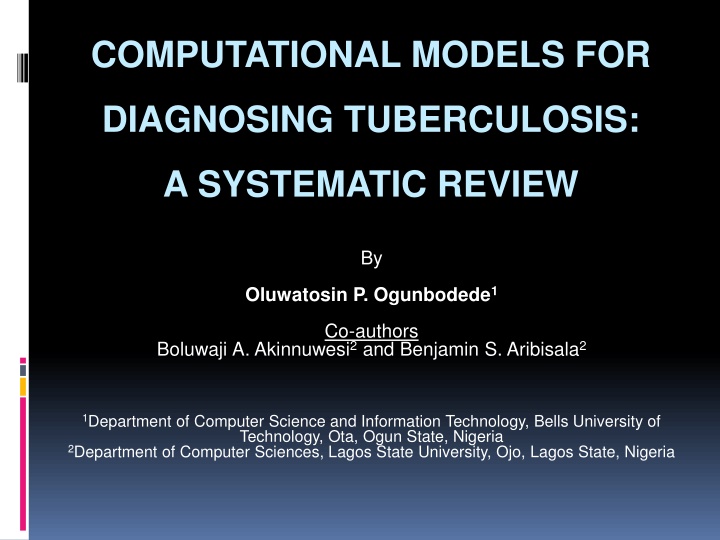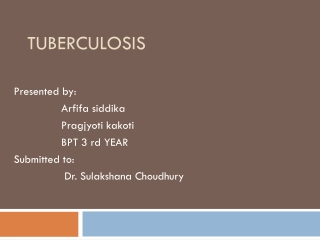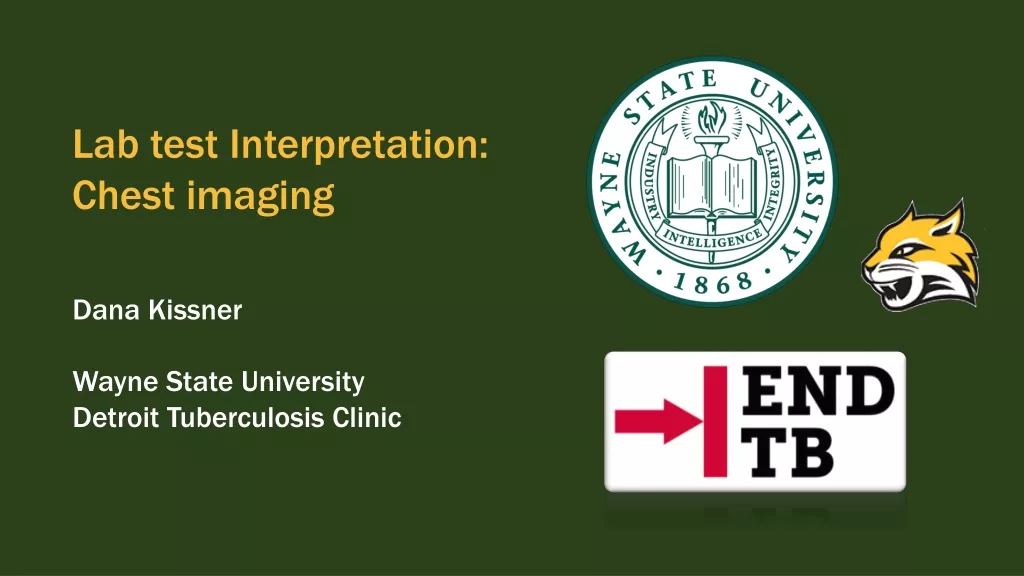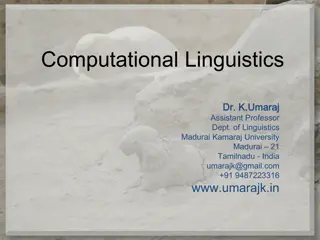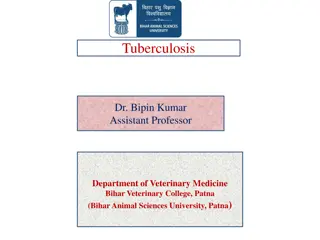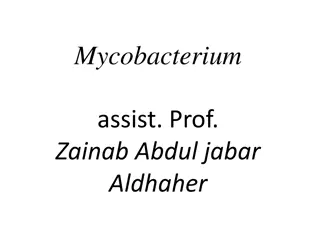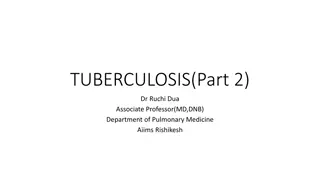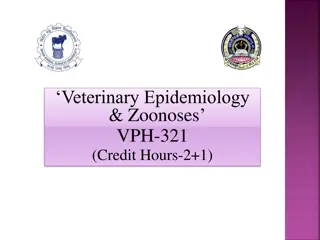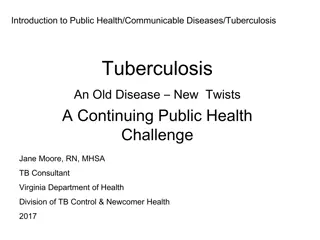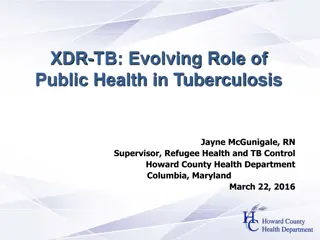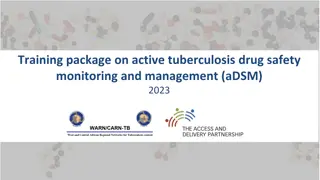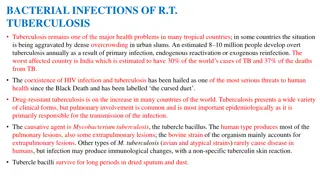Computational Models for Tuberculosis Diagnosis: A Review
This systematic review examines computational models for diagnosing tuberculosis, highlighting strengths, weaknesses, and areas for improvement. The research aims to enhance TB diagnostic accuracy through advanced computational systems.
Download Presentation

Please find below an Image/Link to download the presentation.
The content on the website is provided AS IS for your information and personal use only. It may not be sold, licensed, or shared on other websites without obtaining consent from the author.If you encounter any issues during the download, it is possible that the publisher has removed the file from their server.
You are allowed to download the files provided on this website for personal or commercial use, subject to the condition that they are used lawfully. All files are the property of their respective owners.
The content on the website is provided AS IS for your information and personal use only. It may not be sold, licensed, or shared on other websites without obtaining consent from the author.
E N D
Presentation Transcript
COMPUTATIONAL MODELS FOR DIAGNOSING TUBERCULOSIS: A SYSTEMATIC REVIEW By Oluwatosin P. Ogunbodede1 Co-authors Boluwaji A. Akinnuwesi2and Benjamin S. Aribisala2 1Department of Computer Science and Information Technology, Bells University of Technology, Ota, Ogun State, Nigeria 2Department of Computer Sciences, Lagos State University, Ojo, Lagos State, Nigeria
OUTLINES Introduction Problem statement Aim and Objectives Research Methodology Results Taxonomy Model Areas of weaknesses Conclusion and future work of TB Computational Diagnostic
Introduction Tuberculosis (TB) is an infectious disease- Pathogen Mycobacterium tuberculosis. TB infection Mortality rates - around 1.5 million people/year [1]. About 95% of its victims are from Africa [1]. TB disease is categorized in 3 ways. Immune system (latent or active TB) [2]. Body part infected (pulmonary-lungs extra-pulmonary TB-spine, kidney etc.) Impact area (TB meningitis, TB lymphadenitis, MDR-TB and TB gastrointestinal) and 1. WHO, Global tuberculosis report 2013 2. Voskuil et al. M, Mycobacterium tuberculosis gene expression during adaptation to stationary phase and low-oxygen dormancy. 2004
Risk factors Internal risk factors People who have been previously infected with TB HIV/AIDS Weak immune system [3] Those who are lower than five (5) years old [3] Diabetes (Common comorbidity with TB) worsens glycaemic control External risk factors Poor nutrition Tobacco smoking and alcohol abuse Sharing utensils with sufferers 3. Control, C.f.D. and Prevention, National centre for TB prevention. 2009
Problem Statement Difficulty in diagnosis - either asymptomatic or latent TB Negligence in Nigeria and Sub-Saharan Africa. Need for a more robust computational system for TB diagnosis as a result of slow speed and accuracy of current ones.
Aim and Objectives Aim This research focused on systematic review and analysis of computational models for diagnosis of TB. Objectives Analysis of the strengths and weaknesses of existing computational TB diagnostic models. Overall goal To develop a more accurate computational system for TB diagnosis
Methodology flow diagram Search strategy start Computational, Diagnosis, Tuberculosis. Identify keywords Determine synonyms for major keywords Computational, Soft computing, Fuzzy Logic, et al Establish exclusion criteria Drug, Animal, Imaging, MRI, "X ray", Radiography Diagnosis intitle:Tuberculosis "Fuzzy logic" | "Neural Network" -Animal - imaging Apply Boolean operators
Preferred Reporting Items for Systematic Reviews and Meta- Analysis (PRISMA) diagram [4] Identification Additional records identified through other sources (n = 0) Records identified through database searching (Google scholar) (n = 303) Records screened after duplicates removed (n = 256) Screening Records excluded (n = 183) Full-text articles accessed for eligibility (n = 73) Eligibility Excluded papers (n = 31) No information on outcomes of interest = 18 Empirical data only = 13 Included Studies included in qualitative synthesis (n = 42) 4. Moher, D., et al., Preferred reporting items for systematic reviews and meta-analyses: the PRISMA statement. 2009.
Results: Categorization of the 42 studies Initial search - 303 Only 42 studies met inclusion criteria. Artificial Neural network or neuro-fuzzy 19 studies Expert System 2 studies Fuzzy logic/hybrids 7 studies Bayesian/data mining 7 studies Genetic Algorithm/Hybrid 5 studies Other methods 2 studies
Country of publication of reviewed papers Number of papers 12 10 8 6 4 2 0
Results contd.: Study levels of evidence D1 - Paper validating group studies D2 - Exploratory group studies or meta-analysis D3 - Diagnostic case control study D4 - Study of diagnostic result D5 - Studies not directly related to population 35 Number of papers 30 25 20 15 10 5 0 D1 D2 D3 D4 D5
Taxonomy of TB Computational Diagnostic Models Artificial neural network Strengths Availability of multiple training algorithms It detects complex non-linear relationships between dependent and independent variables. Weakness Training is based on reasonable amount of previous data [5] It depends on input of experts which might be emotional Solution interpretation could be vague and can only be used to induce physician s final decision [6, 7]. 5. Nauck, D. et al. A fuzzy neural network learning fuzzy control rules and membership functions by fuzzy error back propagation,1993. 6. Er, O. et al. Tuberculosis disease diagnosis using artificial neural networks. 2010. 7. Amato, F., et al., Artificial neural networks in medical diagnosis. 2013.
Fuzzy logic/Hybrid based models Strength It has ability to deal with non-linear entities and uncertainties. Weakness They work only if the knowledge about the solution is known and it is expressed using rule based format [8, 9]. The derivation of membership functions (MF) for the fuzzy sets is complex. Identification of the most suitable defuzzification process [10] Use of linguistic variables only [11] etc. 8. Kumari, N. et al, Comparison of ANNs, Fuzzy Logic and Neuro-Fuzzy Integrated Approach for Diagnosis of Coronary Heart Disease: 2013. 9. Godil, S., et al., Fuzzy logic: A" simple" solution for complexities in neurosciences, 2011. 10. Amini, A. et al. Proposing Two defuzzification Methods based on Output Fuzzy Set Weights. 2016 11. Sikchi, S.S., S. Sikchi, and M. Ali, Fuzzy expert systems (FES) for medical diagnosis. 2013
Bayesian/data mining based models Strength It allows us use priors in regularization Weakness Works based on probability theory and hence gives approximate results. Both the BN and DM models were limited by test data [12, 13], thus result precision is not a certainty. 12. Saputra, R.A., PENERAPAN ALGORITMA NA VE BAYES UNTUK PREDIKSI PENYAKIT TUBERCULOSIS (TB). 2016 13. U ar, T. et al Predicting the existence of mycobacterium tuberculosis infection by Bayesian Networks and Rough Sets. 2010
Genetic Algorithm/Hybrid based models Strength It allows the use priors in regularization Weaknesses They work based on internal rules, and therefore, can not be used in loosely defined problems. It follows the Darwinian principles of the survival of the fittest -complex, non-linear model. Accuracy is an issue of concern. [14] generated 61% accuracy on completion and few data sets used [14,15, 16, 17]. 14. Omisore, M.O. et al. A Genetic-Neuro-Fuzzy inferential model for diagnosis of tuberculosis. 2015 15. Asha, T., et al. Optimization of association rules for tuberculosis using genetic algorithm. 2014. 16. Walia, N. et al. Design and identification of tuberculosis using fuzzy based decision support system. 2015 17. Elveren, E et al. Tuberculosis disease diagnosis using artificial neural network trained with genetic algorithm. 2011
Expert system based model Strengths Flexible knowledge base- extendable and updatable They can contain a very large amount of data Weaknesses Limited to information supplied by experts - might be vague and inconclusive. Inferences by experts might be emotionally induced or subject to correction [18]. Limited test data - might not generate the best return on output [18, 19]. 18. Hossain, et al. A Belief Rule Based Expert System to Assess Tuberculosis under Uncertainty. 2017 19. Osamor, V.C. et al. Tuberculosis Diagnostic Expert System: An architecture for translating patients information from the web for use in tuberculosis diagnosis. 2014
Areas of weaknesses in existing computational models Accuracy, speed and worker safety precede over other weaknesses computational models identified in existing S/N Weaknesses Frequency Percentage Accuracy Speed Worker Safety Flexibility Ease of use Specificity analysis Sensitivity analysis 12 8 14 2 3 1 2 28.6 19.0 33.3 4.8 7.1 2.4 4.8 1 2 3 4 5 6 7
Limitation, conclusion and future direction Conclusion Accuracy and speed need to be improved and further quantitative analysis might be required. Also, there is the need for a more robust computational system. Future work Future works will include Quantitative analysis to substantiate and prove the quantity values of the speed and accuracy of the research Development of a comparative computational and conventional techniques. study TB of the diagnosis
THANK YOU
